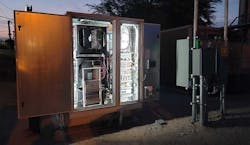Roundtable: Growth Seen Across Many Flavors of Edge Computing
Assessing the state of edge computing is never simple. Whose definition of edge are you using? As we enter 2023, the data center experts in our DCF Executive Roundtable panel say demand is strengthening across nearly all flavors of edge computing, with much more growth to come.
Our panelists include Peter Panfil from Vertiv, Phillip Marangella of EdgeConneX, Schneider Electric's Frank Nash, Shannon Hulbert of Opus Interactive, NTT Global Data Centers' Steven Lim, and Eric Boonstra of Iron Mountain Data Centers. The conversation is moderated by Rich Miller, the founder and editor of Data Center Frontier. Here’s today’s discussion:
Data Center Frontier: What’s the state of the edge computing market, and how does it compare to your expectations? What are the use cases that are gaining traction?
Driving demand for edge are telecom networks, IoT for energy production, video streaming and cloud gaming, retail and public transport apps, as well as multi-point next-gen Industry 4.0 apps.
In general it is hard to define the ‘’edge computing market’’ and the state of it as one sort or type. Edge facilities have so many use cases and add a complimentary extra layer to the data center infrastructure world. But it is sure that what we call edge is a growing segment where smaller footprint facilities will offer rapid deployment, autonomous operation and global integration to support both current and future applications.
For some customers, the edge might be a 1MW facility in a tier-3 market. For a major cloud provider, the edge might be a 40MW data center in a new market driven by data protection rules in that location. For still another business, the edge might be defined as a network of small-footprint locations spread across a continent, combining to deliver far-edge capacity for a narrow set of applications where proximity and low latency are key.
As a result, the opportunities at the edge are extremely promising, as long as you don’t allow yourself to be pigeon-holed into some out-of-date definition of the market in locations around the globe.
First and most importantly, compute-heavy, low-latency applications require a dense, sophisticated edge of the network. There are more of those applications than ever before, and more are on the way. Whether we’re talking about consumer applications, such as gaming, streaming video, telehealth or online shopping, or more business-focused applications tied to point-of-sale processing and analytics, artificial intelligence, virtual and augmented reality or machine learning, or addressing a more distributed workforce in a post-Covid world, it all depends on ultra-fast, intelligent, secure networks. These are hybrid networks that incorporate enterprise and cloud as well, but the edge makes it all sing.
In terms of use cases, it’s hard to point to a corner of the economy that isn’t increasingly dependent on the edge of the network. A few areas to watch include (1) artificial intelligence/augmented reality/machine learning – these applications require ultra-fast computing and analytics; (2) telemedicine and telehealth, which were high-potential but low-use niche offerings before Covid but now are significant sources of investment across the healthcare space; and (3) retailers racing to deploy edge computing to enhance the customer experience across all interactions – including in the store – in an effort to hold onto their market share as the on-line marketplace evolves.
We all know that productivity tools, collaboration tools, AI/ML, 5G are all driving growth in edge computing market as data and compute needs to be done faster and therefore closer to the point of origin. As a result, we are seeing an increase in demand in tier-2 cities, and we are investigating how we can serve this growing part of the data center market.
Within that context, we are also working on newer designs in the data center itself which might allow us to build at smaller scales and therefore deliver capacity faster in these smaller markets. That said, for edge to work, connectivity back to the core markets are still critical and that’s where NTT’s strengths and future strategies are poised to help.
It doesn’t mean the death of centralized cloud by any means, but it does mean we will operate in a hybrid world of both centralized and decentralized cloud. Some may call it “Edge Cloud.” The fact is that there will be multitudes of compute resources in multitudes of places and not just many in one place (hyperscale). It is becoming the internet of EVERYTHING, not the internet of things as we see the hyperscalers moving out to the edge.
First car data-as-a-service (withTesla), now a true satellite-to-cellular service partnership with T-mobile.
NEXT: The outlook for enterprise IT data center demand in 2023.
Keep pace with the fact-moving world of data centers and cloud computing by following us on Twitter and Facebook, connecting with DCF on LinkedIn, and signing up for our weekly newspaper using the form below:
About the Author









